Continuous Detection of Forest Loss in Vietnam, Laos, and Cambodia Using Sentinel-1 Data
Abstract
:1. Introduction
2. Materials and Methods
2.1. Study Area
2.2. Forest Definition
2.3. Data
2.3.1. Sentinel-1 Data
2.3.2. Forest/Non-Forest Map
2.4. Method
2.4.1. Pre-Processing
2.4.2. Masking
2.4.3. Forest Loss Detection Method
- The detection of shadows that appear at the boundary between forest and forest loss areas in a series of images;
- The detection of the deforested patches associated with the shadows (which we call “reconstructed patches”).
- The values of the two thresholds applied to the RCR used to detect shadows and reconstructed patches;
- The polarization to be used.
2.4.4. Validation
3. Results and Discussion
3.1. Forest Loss Map
3.2. Validation Results
- The estimated user accuracy (±95% confidence interval) is 0.950 ± 0.043 for forest disturbances and 0.993 ± 0.005 for intact forest (including buffer areas around disturbances).
- The estimated producer accuracy is 0.898 ± 0.061 for forest disturbances and 0.997 ± 0.043 for intact forest.
- The estimated overall accuracy is 0.991 ± 0.006.
3.3. Comparison with GFW and GLAD
4. Conclusions
Author Contributions
Funding
Institutional Review Board Statement
Informed Consent Statement
Data Availability Statement
Acknowledgments
Conflicts of Interest
References
- Vancutsem, C.; Achard, F.; Pekel, J.-F.; Vieilledent, G.; Carboni, S.; Simonetti, D.; Gallego, J.; Aragão, L.E.O.C.; Nasi, R. Long-term (1990–2019) monitoring of forest cover changes in the humid tropics. Sci. Adv. 2021, 7, eabe1603. [Google Scholar] [CrossRef] [PubMed]
- FAO. Global Forest Resources Assessment; Technical Report; Food and Agriculture Association of the United-States: Rome, Italy, 2020. [Google Scholar]
- Wheeler, D.; Hammer, D.; Kraft, R.; Steelr, A. Satellite-Based Forest Clearing Detection in the Brazilian Amazon: FORMA, DETER, and PRODES. 2014. Available online: https://www.wribrasil.org.br/sites/default/files/forma-issue-brief_1.pdf (accessed on 25 June 2021).
- Reymondin, L.; Jarvis, A.; Perez-Uribe, A.; Touval, J.; Argote, K.; Coca, A.; Rebetez, J.; Guevara, E.; Mulligan, M. Terra-i: A Methodology for Near Real-Time Monitoring of Habitat Change at Continental Scales Using MODIS-NDVI and TRMM. 2012. Available online: www.terra-i.org/dam/jcr:508a0e27-3c91-4022-93dd-81cf3fe31f42/Terra-i%20Method.pdf (accessed on 14 June 2021).
- Diniz, C.G.; Souza, A.A.D.A.; Santos, D.C.; Dias, M.C.; Luz, N.; de Moraes, D.R.V.; Maia, J.S.A.; Gomes, A.R.; Narvaes, I.D.S.; Valeriano, D.M.; et al. DETER-B: The New Amazon Near Real-Time Deforestation Detection System. IEEE J. Sel. Top. Appl. Earth Obs. Remote Sens. 2015, 8, 3619–3628. [Google Scholar] [CrossRef]
- Hansen, M.C.; Krylov, A.; Tyukavina, A.; Potapov, P.V.; Turubanova, S.; Zutta, B.; Ifo, S.; Margono, B.; Stolle, F.; Moore, R. Humid tropical forest disturbance alerts using Landsat data. Environ. Res. Lett. 2016, 11, 034008. [Google Scholar] [CrossRef]
- Reiche, J.; Lucas, R.; Mitchell, A.L.; Verbesselt, J.; Hoekman, D.H.; Haarpaintner, J.; Kellndorfer, J.M.; Rosenqvist, A.; Lehmann, E.A.; Woodcock, C.E.; et al. Combining satellite data for better tropical forest monitoring. Nat. Clim. Chang. 2016, 6, 120–122. [Google Scholar] [CrossRef]
- Watanabe, M.; Koyama, C.; Hayashi, M.; Kaneko, Y.; Shimada, M. Development of Early-Stage Deforestation Detection Algorithm (Advanced) with PALSAR-2/ScanSAR for JICA-JAXA Program (JJ-FAST); IEEE: Fort Worth, TX, USA, 2017; pp. 2446–2449. [Google Scholar]
- Belenguer-Plomer, M.A.; Tanase, M.A.; Fernandez-Carrillo, A.; Chuvieco, E. Burned area detection and mapping using Sentinel-1 backscatter coefficient and thermal anomalies. Remote Sens. Environ. 2019, 233, 111345. [Google Scholar] [CrossRef]
- Hoekman, D.; Kooij, B.; Quiñones, M.; Vellekoop, S.; Carolita, I.; Budhiman, S.; Arief, R.; Roswintiarti, O. Wide-Area Near-Real-Time Monitoring of Tropical Forest Degradation and Deforestation Using Sentinel-1. Remote Sens. 2020, 12, 3263. [Google Scholar] [CrossRef]
- Doblas, J.; Shimabukuro, Y.; Sant’Anna, S.; Carneiro, A.; Aragão, L.; Almeida, C. Optimizing near real-time detection of deforestation on tropical rainforests using Sentinel-1 data. Remote Sens. 2020, 12, 3922. [Google Scholar] [CrossRef]
- Reiche, J.; Mullissa, A.; Slagter, B.; Gou, Y.; Tsendbazar, N.-E.; Odongo-Braun, C.; Vollrath, A.; Weisse, M.J.; Stolle, F.; Pickens, A.; et al. Forest disturbance alerts for the Congo Basin using Sentinel-1. Environ. Res. Lett. 2021, 16, 024005. [Google Scholar] [CrossRef]
- Bouvet, A.; Mermoz, S.; Ballère, M.; Koleck, T.; Le Toan, T. Use of the SAR Shadowing Effect for Deforestation Detection with Sentinel-1 Time Series. Remote Sens. 2018, 10, 1250. [Google Scholar] [CrossRef] [Green Version]
- Hirschmugl, M.; Deutscher, J.; Sobe, C.; Bouvet, A.; Mermoz, S.; Schardt, M. Use of SAR and Optical Time Series for Tropical Forest Disturbance Mapping. Remote Sens. 2020, 12, 727. [Google Scholar] [CrossRef] [Green Version]
- Ballère, M.; Bouvet, A.; Mermoz, S.; Le Toan, T.; Koleck, T.; Bedeau, C.; André, M.; Forestier, E.; Frison, P.-L.; Lardeux, C. SAR data for tropical forest disturbance alerts in French Guiana: Benefit over optical imagery. Remote Sens. Environ. 2021, 252, 112159. [Google Scholar] [CrossRef]
- Tanase, M.A.; Aponte, C.; Mermoz, S.; Bouvet, A.; Le Toan, T.; Heurich, M. Detection of windthrows and insect outbreaks by L-band SAR: A case study in the Bavarian Forest National Park. Remote Sens. Environ. 2018, 209, 700–711. [Google Scholar] [CrossRef]
- Olofsson, P.; Foody, G.M.; Herold, M.; Stehman, S.V.; Woodcock, C.E.; Wulder, M.A. Good practices for estimating area and assessing accuracy of land change. Remote Sens. Environ. 2014, 148, 42–57. [Google Scholar] [CrossRef]
- Olofsson, P.; Arévalo, P.; Espejo, A.B.; Green, C.; Lindquist, E.; McRoberts, R.E.; Sanz, M.J. Mitigating the effects of omission errors on area and area change estimates. Remote Sens. Environ. 2020, 236, 111492. [Google Scholar] [CrossRef]
- Afelt, A.; Frutos, R.; Devaux, C. Bats, Coronaviruses, and Deforestation: Toward the Emergence of Novel Infectious Diseases? Front. Microbiol. 2018, 9, 702. [Google Scholar] [CrossRef] [PubMed] [Green Version]
- Potapov, P.; Tyukavina, A.; Turubanova, S.; Talero, Y.; Hernandez-Serna, A.; Hansen, M.; Saah, D.; Tenneson, K.; Poortinga, A.; Aekakkararungroj, A.; et al. Annual continuous fields of woody vegetation structure in the Lower Mekong region from 2000–2017 Landsat time-series. Remote Sens. Environ. 2019, 232, 111278. [Google Scholar] [CrossRef]
- Hansen, M.C.; Potapov, P.V.; Moore, R.; Hancher, M.; Turubanova, S.A.; Tyukavina, A.; Thau, D.; Stehman, S.V.; Goetz, S.J.; Loveland, T.R.; et al. High-resolution global maps of 21st-century forest cover change. Science 2013, 342, 850–853. [Google Scholar] [CrossRef] [Green Version]
- Koleck, T.; Ballère, M.; Marie-Sainte, W. S1Tiling, A Multipurpose Open Source Processing Chain for Sentinel-1 Time Series. In Proceedings of the Living Planet Symposium, Milan, Italy, 13–17 May 2019. [Google Scholar]
- Inglada, J.; Christophe, E. The Orfeo Toolbox remote sensing image processing software. In Proceedings of the 2009 IEEE International Geoscience and Remote Sensing Symposium, Cape Town, South Africa, 12–17 July 2009; Volume 4, p. IV-733. [Google Scholar]
- Quegan, S.; Yu, J.J. Filtering of multichannel SAR images. IEEE Trans. Geosci. Remote Sens. 2001, 39, 2373–2379. [Google Scholar] [CrossRef]
- Mermoz, S.; Le Toan, T.; Villard, L.; Réjou-Méchain, M.; Seifert-Granzin, J. Biomass assessment in the Cameroon savanna using ALOS PALSAR data. Remote Sens. Environ. 2014, 155, 109–119. [Google Scholar] [CrossRef]
- Mermoz, S.; Le Toan, T. Forest Disturbances and Regrowth Assessment Using ALOS PALSAR Data from 2007 to 2010 in Vietnam, Cambodia and Lao PDR. Remote Sens. 2016, 8, 217. [Google Scholar] [CrossRef] [Green Version]
- Bruniquel, J.; Lopes, A. Multi-variate optimal speckle reduction in SAR imagery. Int. J. Remote Sens. 1997, 18, 603–627. [Google Scholar] [CrossRef]
- Pekel, J.-F.; Cottam, A.; Gorelick, N.; Belward, A.S. High-resolution mapping of global surface water and its long-term changes. Nature 2016, 540, 418–422. [Google Scholar] [CrossRef] [PubMed]
- Bunting, P.; Rosenqvist, A.; Lucas, R.; Rebelo, L.-M.; Hilarides, L.; Thomas, N.; Hardy, A.; Itoh, T.; Shimada, M.; Finlayson, C.M. The Global Mangrove Watch—A New 2010 Global Baseline of Mangrove Extent. Remote Sens. 2018, 10, 1669. [Google Scholar] [CrossRef] [Green Version]
- Google Earth. 2011. Available online: https://www.google.com/intl/fr/earth/ (accessed on 14 September 2021).
- Witness, G. Rubber Barons: How Vietnamese Companies and International Financiers Are Driving a Land Grabbing Crisis in Cambodia and Laos; Global Witness: London, UK, 2013. [Google Scholar]
- Xiao, C.; Li, P.; Feng, Z.; Liu, Y.; Zhang, X. Sentinel-2 red-edge spectral indices (RESI) suitability for mapping rubber boom in Luang Namtha Province, northern Lao PDR. Int. J. Appl. Earth Obs. Geoinf. 2020, 93, 102176. [Google Scholar] [CrossRef]
- Hurni, K.; Fox, J. The expansion of tree-based boom crops in mainland Southeast Asia: 2001 to 2014. J. Land Use Sci. 2018, 13, 198–219. [Google Scholar] [CrossRef]
- UNEP-WCMC and IUCN. Protected Planet: The World Database on Protected Areas (WDPA). On-Line, Downloaded in June 2021; UNEP-WCMC and IUCN: Cambridge, UK, 2021; Available online: www.protectedplanet.net (accessed on 5 July 2021).
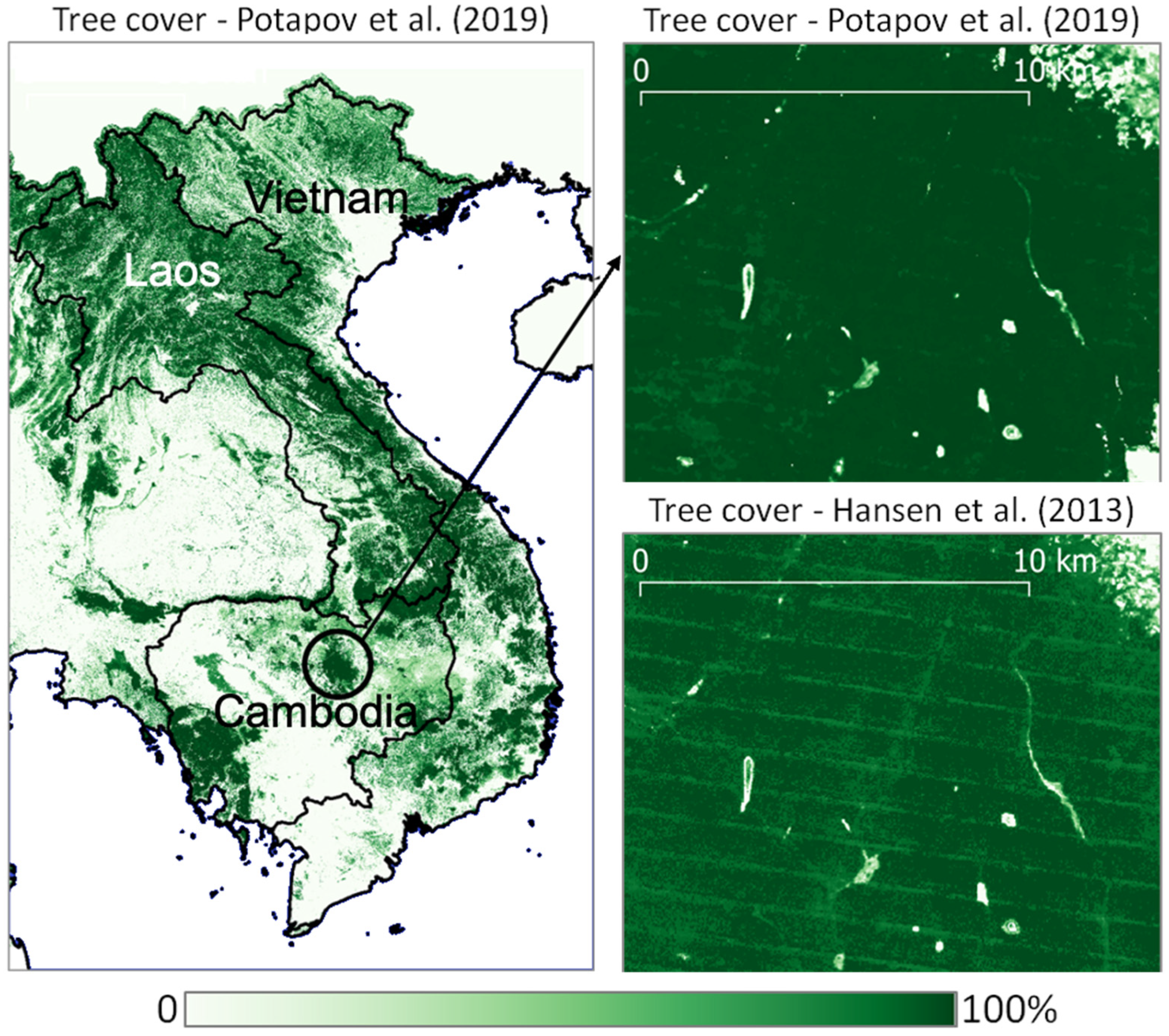
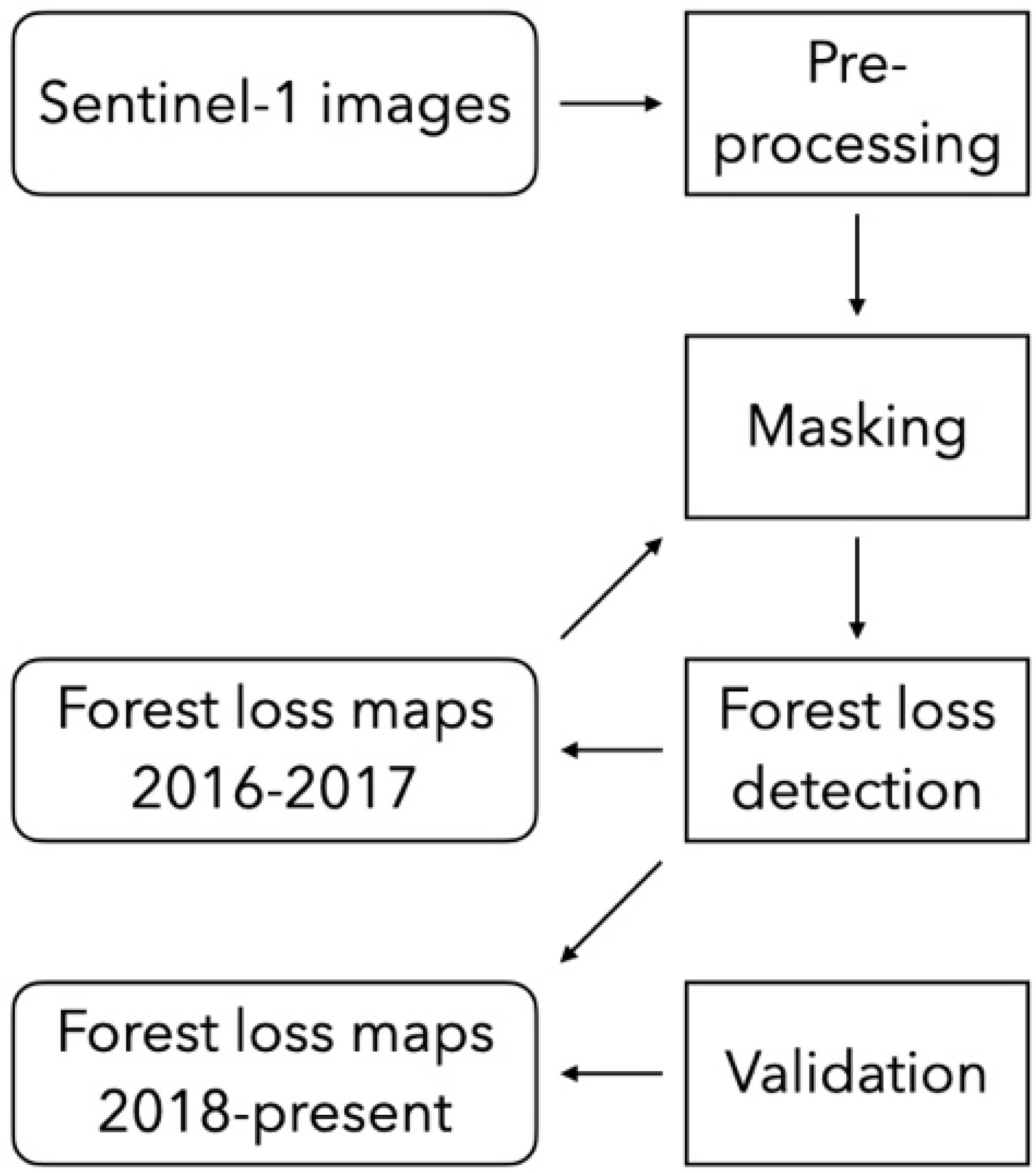
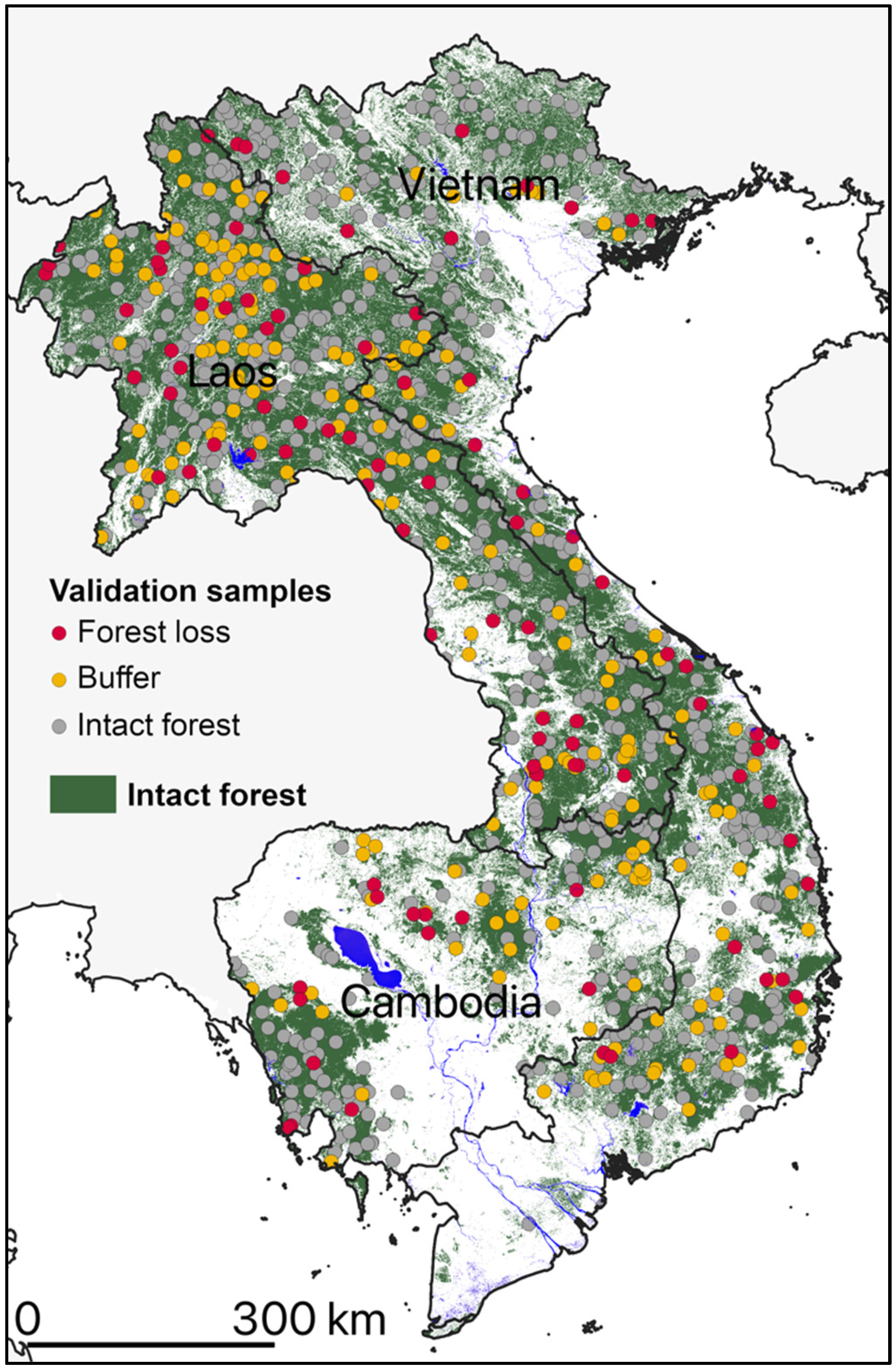
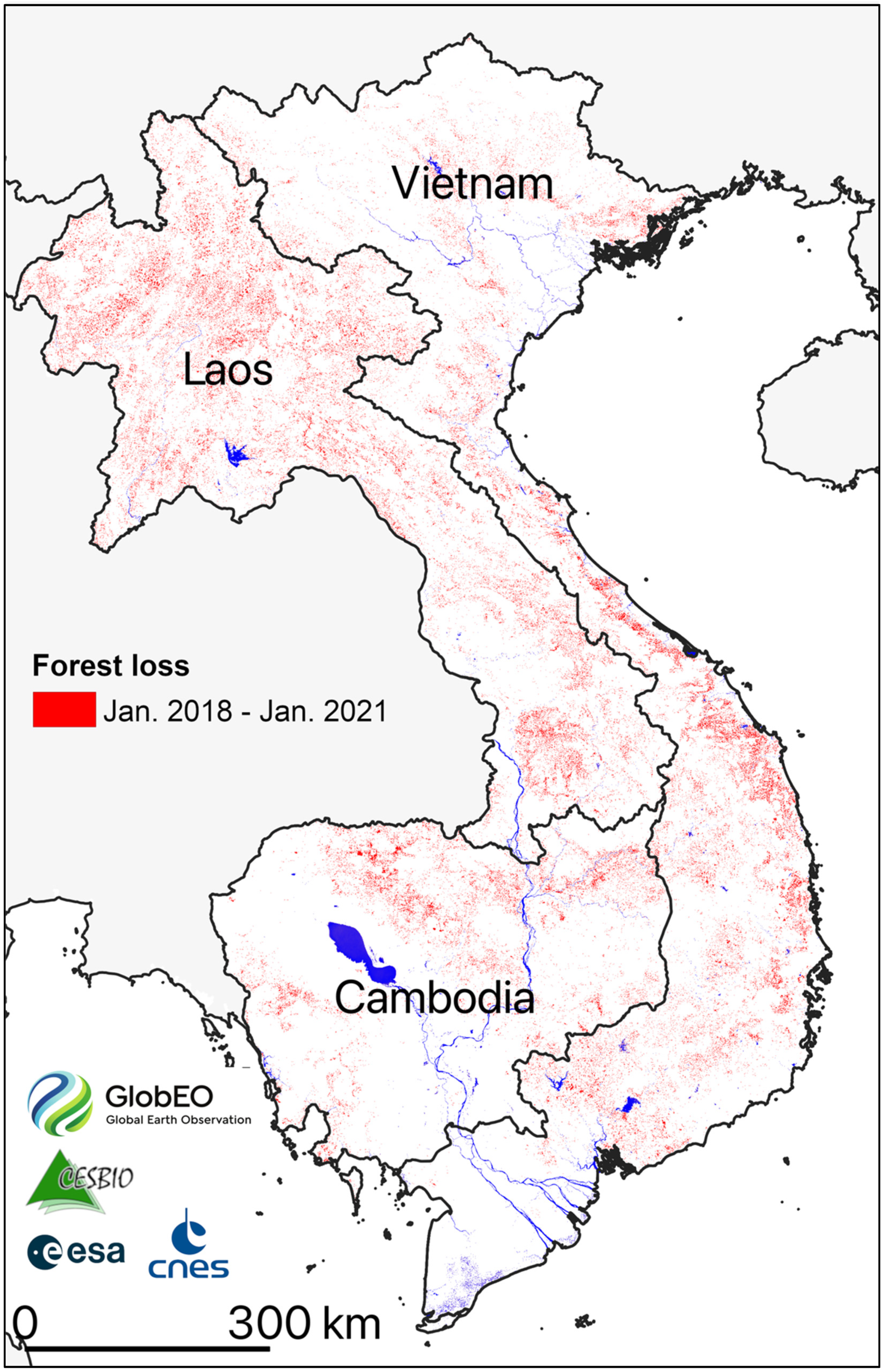
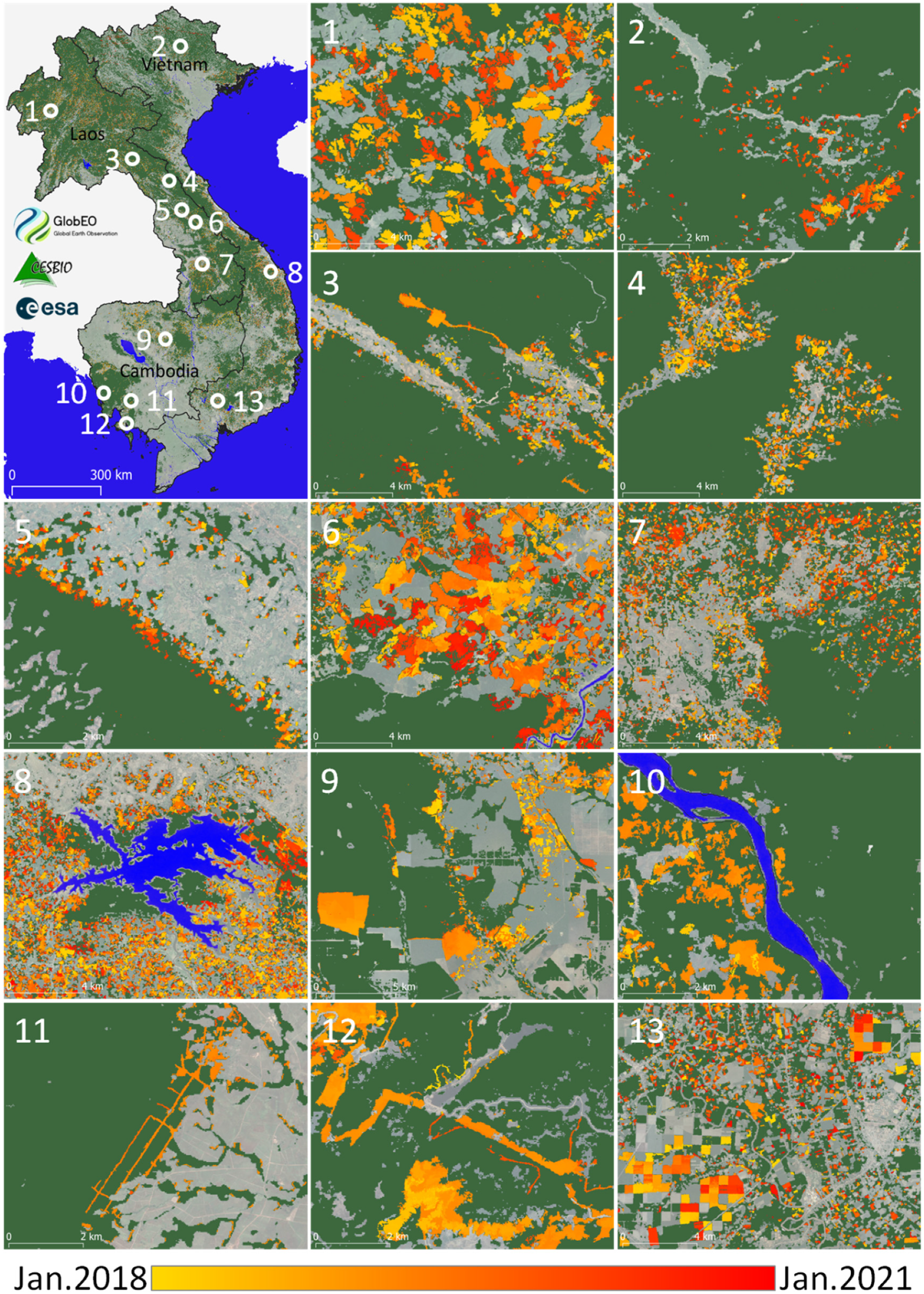
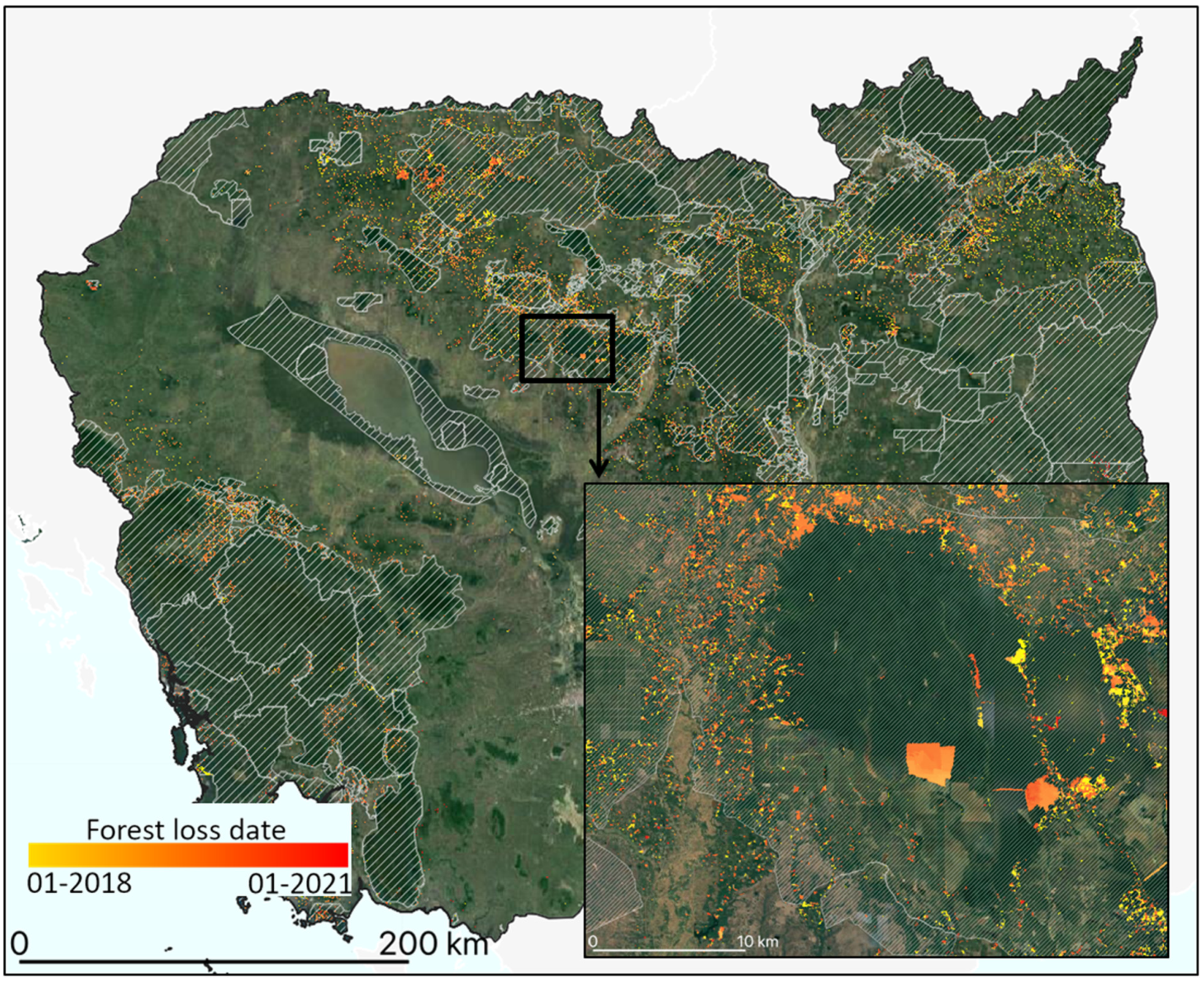
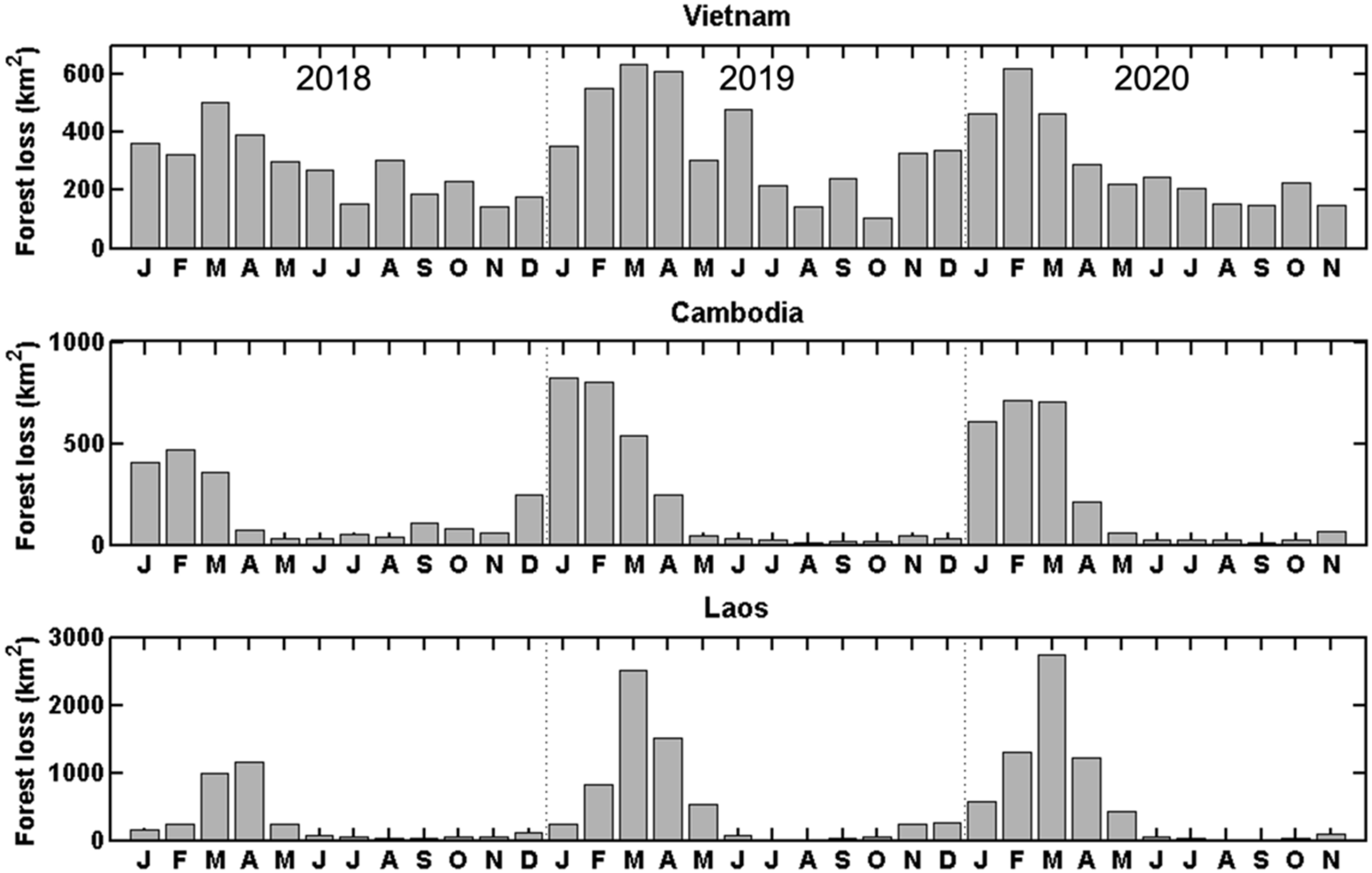
| Vietnam | Cambodia | Laos | |
|---|---|---|---|
| Forest area 1990 (ha × 103) | 9376 | 11,005 | 17,843 |
| Forest area 2000 (ha × 103) | 11,784 | 10,781 | 17,425 |
| Forest area 2010 (ha × 103) | 13,388 | 10,589 | 16,940 |
| Forest area 2020 (ha × 103) | 14,643 | 8068 | 16,595 |
| Forest area % of land area 2020 | 47.2 | 45.7 | 71.9 |
| Primary forest % of forest area 2020 | 0.5 | 4 | - |
| Reference | ||||
|---|---|---|---|---|
| Disturbances | Intact | Total | ||
| Map | Disturbances | 96 | 5 | 101 |
| Intact buffer | 3 | 194 | 197 | |
| Intact | 3 | 693 | 696 | |
| Total | 102 | 892 | 994 | |
| Reference | |||||
|---|---|---|---|---|---|
| Disturbances | Intact | Total (Wi) | Am,i (km2) | ||
| Map | Disturbances | 5.55% | 0.29% | 5.84% | 22,222 |
| Intact buffer | 0.28% | 18.30% | 18.58% | 70,667 | |
| Intact | 0.33% | 75.25% | 75.58% | 287,462 | |
| Total | 6.16% | 93.84% | 100% | 380,351 | |
| This Study (ha) | GFW (ha) [21] | GFW Minus This Study (%) | GLAD (ha) [6] | |
|---|---|---|---|---|
| Vietnam 2018 | 345,121 | 422,300 | 22 | - |
| Vietnam 2019 | 445,977 | 421,910 | −5 | 83,361 |
| Vietnam 2020 | 333,655 | 397,066 | 19 | 82,174 |
| Cambodia 2018 | 200,400 | 180,970 | −10 | - |
| Cambodia 2019 | 281,335 | 236,780 | −16 | 119,042 |
| Cambodia 2020 | 262,448 | 230,317 | −12 | 105,963 |
| Laos 2018 | 327,152 | 400,290 | 22 | - |
| Laos 2019 | 648,089 | 498,830 | −23 | 153,187 |
| Laos 2020 | 650,040 | 477,299 | -26 | 164,201 |
Publisher’s Note: MDPI stays neutral with regard to jurisdictional claims in published maps and institutional affiliations. |
© 2021 by the authors. Licensee MDPI, Basel, Switzerland. This article is an open access article distributed under the terms and conditions of the Creative Commons Attribution (CC BY) license (https://creativecommons.org/licenses/by/4.0/).
Share and Cite
Mermoz, S.; Bouvet, A.; Koleck, T.; Ballère, M.; Le Toan, T. Continuous Detection of Forest Loss in Vietnam, Laos, and Cambodia Using Sentinel-1 Data. Remote Sens. 2021, 13, 4877. https://doi.org/10.3390/rs13234877
Mermoz S, Bouvet A, Koleck T, Ballère M, Le Toan T. Continuous Detection of Forest Loss in Vietnam, Laos, and Cambodia Using Sentinel-1 Data. Remote Sensing. 2021; 13(23):4877. https://doi.org/10.3390/rs13234877
Chicago/Turabian StyleMermoz, Stéphane, Alexandre Bouvet, Thierry Koleck, Marie Ballère, and Thuy Le Toan. 2021. "Continuous Detection of Forest Loss in Vietnam, Laos, and Cambodia Using Sentinel-1 Data" Remote Sensing 13, no. 23: 4877. https://doi.org/10.3390/rs13234877
APA StyleMermoz, S., Bouvet, A., Koleck, T., Ballère, M., & Le Toan, T. (2021). Continuous Detection of Forest Loss in Vietnam, Laos, and Cambodia Using Sentinel-1 Data. Remote Sensing, 13(23), 4877. https://doi.org/10.3390/rs13234877






